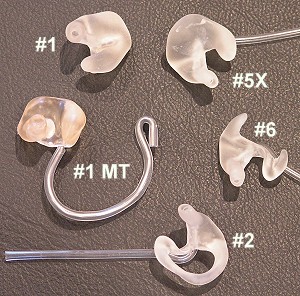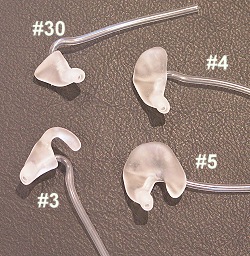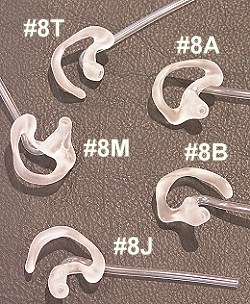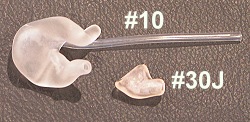|
 # 1 REGULAR EARMOLD RECEIVER # 1 REGULAR EARMOLD RECEIVER
This mold style is characterized by a special receiver ring that retains the external receiver of a body aid. The mold fills all the contours of the external ear for a tight seal. This type of earmold can be made from hard or soft materials. **Other uses for the receiver mold include custom earmolds for pilots, anaesthetist, AIE listening molds, police communications.
# 1 MT RECEIVER WITH HOOK
This earmold style was developed to retain a receiver and mold in the ear of a client where the external ear’s cartilage will not hold the mold in place. The most common application is small children.
# 5X RECEIVER EARMOLD WITH TUBING
Because the receiver mold gives a superior seal, this mold can be adapted to use with ear level and eyeglass aids.
# 2 SKELETON
This is the most universal mold made. The design gives a good seal, and the cosmetic design is adaptable to most clients. Most acoustical options can be fitted into this physical shape.
# 6 HALF PHANTOM
This mold is a reduction of the skeleton style. This style can provide the client acoustic seal while adapting to any problem areas in the external ear’s shape.
|
# 30 CANAL
This mold is the maximum reduction possible. Only the canal portion remains. Cosmetically, this is the ultimate in concealment. Since there are no retainer areas on this mold in the helix or concha a long canal is recommended for retention purpose.
# 3 CANAL LOCK
This mold is a modified canal shape. As shown a portion of the lower concha rim has been added to give more retention. The mold still is cosmetically very acceptable.
# 4 SHELL CANAL (HALF SHELL)
This mold focuses on the very real client/dispenser problem of earmold insertion. Some clients, due to age or manual dexterity, do not easily learn insertion technique. This mold gives good acoustic seal and simplifies insertion for the client.
|

|
# 5 SHELL
This mold was created from the design of the Receiver Earmold with tubing. The receiver plate area of the mold has been belled in for cosmetic reasons. This mold will work in all cases because of its seal and design. Most acoustical options can be used with this physical shape.
 # 8 A C.R.O.S. (Original C.R.O.S.) # 8 A C.R.O.S. (Original C.R.O.S.)
Basically, a C.R.O.S. mold is a reduction of a skeleton mold in the bridge area and the reduction of the canal portion of the mold so the patient’s canal is not occluded. Sound can pass around the retaining portions of a C.R.O.S. mold. C.R.O.S. molds are used in C.R.O.S. and I.R.O.S. fittings to significantly reduce an aid’s response below 1000 Hz. It can be said that a C.R.O.S. mold is the largest vent.
# 8 B C.R.O.S.
A modification of the original 8A C.R.O.S. with the bridge of the earmold removed.
# 8 J Janssen
This non-occluded earmold was developed to replace tube fittings. The Janssen mold has design changes from the earlier C.R.O.S. type configuration. The canal portion of the mold runs along the TOP of the ear canal.
# 8 T Tinnitus
A modification of the 8B C.R.O.S. developed for use with a tinnitus masker.
# 8 M Non-Occluding Universal
A non-occluding earmold style that consolidates the features of other mold styles to maximize its effectiveness. This mold uses a S.A.V., variable vent system, installed in the bridge of an almost original C.R.O.S. mold. The canal portion of this mold runs along the top of the ear canal like a Janssen Mold. This mold offers the dispenser the benefits of a Free Field Mold, a Janssen Mold and variable venting.
 CUSTOM EARMOLDS FOR EXCESSIVE MANDIBULAR MOVEMENT CUSTOM EARMOLDS FOR EXCESSIVE MANDIBULAR MOVEMENT
|
# 10 POWER MOLD
Some feedback problems have as their origin the movement of the jaw as it affects the ear canal. This movement causes the seal created by the earmold to break and feedback occurs. The movement in the ear canal can be by-passed by this physical design. The canal portion of a shell mold is reduced to a tubing size for part of the canal length.
# 30 J
A deep fitting “hollow” canal style earmold tapered for profound hearing losses in patient’s with excessive jaw movement
|

|
.
 STINT MOLD STINT MOLD
For normal hearing persons with prolapsed ear canals. The opening of the sound channel is shaped like “funnel” with as large a bore as possible in the center to allow maximum amount of sound to reach the eardrum. Most earmold styles can be used for this special need.
|